16 Perennials That Attract Hummingbirds to Your Garden!
Perennials for hummingbirds. Love having hummingbirds visit your garden? Expand your garden space to attract hummingbirds. And if you don’t have hummingbirds then, create a place for them.
We all love seeing those magnificent little hummingbirds flutter by. They are quick. And easy to miss as they whiz by. These active hummingbirds devour an incredible amount of food. Nectar from flowers is needed to sustain themselves throughout the day. Some hummingbird species feed every 10 to 15 minutes. They visit over 1000 flowers in a day!
Interested in attracting hungry hummingbirds to your garden space? Plant perennials for hummingbirds. That is perennials that hummingbirds are attracted to. Something to remember is to provide a variety of perennials. Perennials with different blooming periods throughout the seasons. Plant Spring, Summer, and Fall blooming plants. A hummingbird garden should have nectar rich plants blooming for long periods. Grow continuously blooming plants from one season to the next.
We’ve rounded up 16 nectar rich perennials for hummingbirds. Plants that attract these beautiful birds to your garden space. And plants that’ll invite them to return for more nectar throughout the season. Take a look and let us know what you think.
-
Monarda
Monarda is also known as Bee Balm, Bergamot, and Oswego Tea. Bees, butterflies, and hummingbirds are attracted to Monarda. A North American native perennial and part of the mint family. Bright colorful blooms with fragrant foliage. Bee Balm is a great attraction to hummingbirds and other pollinators. Use for making potpourri or herbal wreaths and teas.
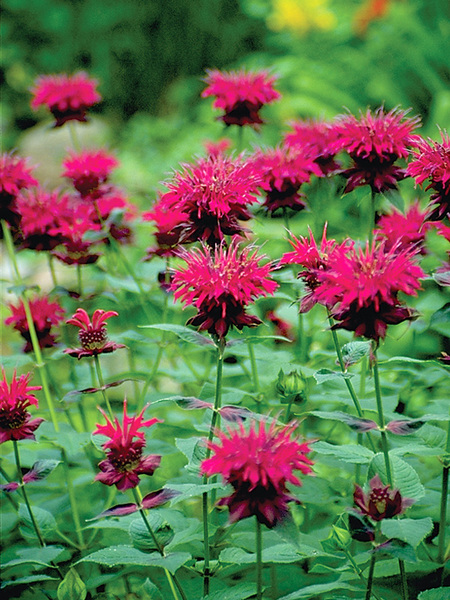
Raspberry Wine Monarda has berry red tubular flowers. Early formed buds resemble raspberries. Blooms from early Summer to early Fall. Grows in zones 4 to 9 in part Sun and part shade to full Sun. Reaches 30 inches tall. Beneficial to pollinators. Attracts butterflies and hummingbirds. Deer and rabbit resistant. Fragrant long blooming perennial that can be used as cut flowers too. Tolerant of clay soil and wet site conditions.

Balmy Rose Monarda has bold rose pink flowers. Blooms from late Spring to midSummer. Grows in zones 4 to 9 in full Sun to mostly sunny. Reaches 10 to 12 inches tall. Beneficial to pollinators. Attracts butterflies and hummingbirds. Deer and rabbit resistant. Long blooming perennial that can be used as cut flowers too. Tolerant of clay soil and wet site conditions.

Balmy Pink Monarda has spiky pink flowers, similar to the finale of a fireworks display. Blooms from late Spring to midSummer. Grows in zones 4 to 9 in full Sun to mostly sunny. Reaches 10 to 12 inches tall. Beneficial to pollinators, attracts butterflies and hummingbirds. Deer and rabbit resistant. Long blooming perennial that can be used as cut flowers too. Tolerant of clay soil and wet site conditions.
2. Hibiscus
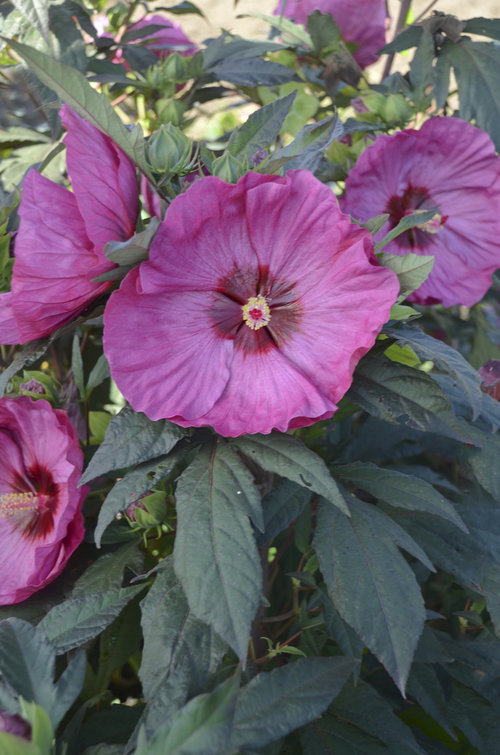
Rose Mallow Hibiscus has lavender pink blooms. Hibiscus Rose mallow blooms are 7 to 8 inches wide with ruffled petals and a cherry red eye. Blooms from midSummer to early Fall. Grows in zones 4 to 9 in part shade and part Sun to full Sun. Topping out between 40 to 48 inches. Attracts hummingbirds. Deer resistant. A densely compact shrub-like North American native. Rose Mallow is part of the Summerific series.
3. Salvia
Salvia is also known as Meadow Sage. A tried and true perennial. Ideal for dried or cut flower arrangements. Produces an intense show of color over the Summer months. Pollinators are drawn to Salvia floral spikes. Performs best in full Sun. Deer resistant.

Perennials for Hummingbirds – Midnight Model Salvia
Midnight Model Salvia has vibrant-blue flower spikes with lush foliage. Blooms late Spring to early Summer. Forms a dense mounding growth habit. Grows in zones 3 to 8 in mostly sunny to full Sun. Reaches 22 to 24 inches tall. Beneficial to pollinators, attracts butterflies and hummingbirds. Deer and rabbit resistant. Long blooming perennial that can be grown in containers. Ideal for cut flowers. Tolerant of sandy soil conditions. Plant on a slope or bank. Tolerant of hot dry site and seaside/salt conditions. Hybridized at Walters Gardens.

Perennials for Hummingbirds – Pretty in Pink Salvia
Pretty in Pink Salvia has bright lavender pink flowers with lush foliage. Blooms late Spring to early Summer. Grows in zones 3 to 8 in mostly sunny to full Sun. Reaches 18 to 20 inches tall. Beneficial to pollinators, attracts butterflies and hummingbirds. Deer and rabbit resistant. Long blooming perennial that can be grown in containers. Ideal for cut flowers. Tolerant of sandy soil conditions. Plant on a slope or bank. Tolerant of hot dry site and seaside/salt conditions. Hybridized at Walters Gardens.

Perennials for Hummingbirds – Bumbleblue Salvia
Bumbleblue Salvia has intense violet blue flowers with deep green foliage. Blooms early to mid Summer. Grows in zones 3 to 8 in mostly sunny to full Sun. Reaches 12 to 14 inches tall. Beneficial to pollinators. Attracts butterflies and hummingbirds. Deer and rabbit resistant. Long blooming, petite perennial that can be grown in containers. Ideal for cut flowers. Tolerant of sandy or clay soil conditions. Plant on a slope or bank. Tolerant of hot dry site and seaside/salt conditions.
4. Phlox
Phlox is also known as a garden phlox. Considered the perennial garden “backbone”. Phlox provides unrivaled flowering over the Summer months. Crisp colors and fragrant blooms. Makes excellent cut flower bouquet. A great selection for colder climates.
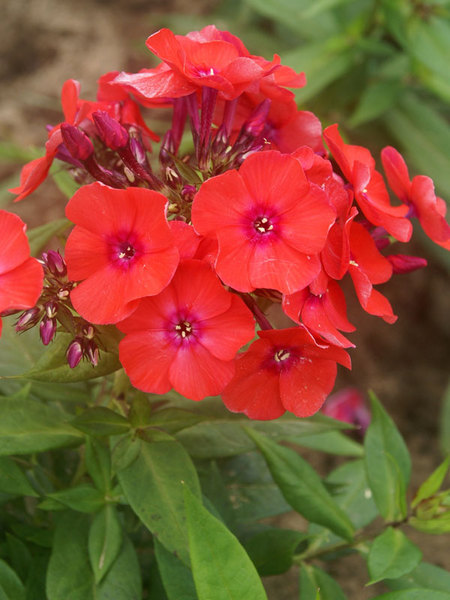
Orange Perfection Phlox has salmon orange blooms. Blooms late Summer to early Fall. Grows in zones 4 to 8 in full Sun. Reaches 36 inches tall. Fragrant perennial attracts butterflies and hummingbirds. A long blooming perennial that can be used for cut flowers.

Cosmopolitan Phlox has bright pink blooms. Blooms from mid Summer to early Fall. Grows in zones 4 to 8 in full Sun. Tops out at 12 to 16 inches tall. Attracts butterflies and hummingbirds. Long blooming fragrant perennial that can be used as cut flowers. Tolerant of sandy and clay soil conditions. Mid Summer color at its best.

Cloudburst Tall Cushion Phlox has lavender purple flowers with bright pink eyes. Foliage has dark green leaves. Blooms in the Summer. Grows in zones 4 to 8 in full Sun. Reaches 26 to 28 inches tall. Fragrant long blooming perennial. Attracts butterflies and hummingbirds. Mounding growth habit and native North American perennial. Plant Cloudburst in garden borders, containers, or in mass plantings. Use as cut flowers.
5. Agastache
Agastache is known as Hyssop or Hummingbird Mint. Blooms are attractive to hummingbirds and butterflies. Goldfinches are drawn to the seeds. Scented foliage can be used to flavor drinks. Plant in a garden border or in a container.

Perennials for Hummingbirds – Firebird Agastache
Firebird Agastache has nectar rich filled blooms that are fiery coppery, orange-coral in color. Foliage is a striking gray-green. Blooms early Summer to early Fall. Grows in zones 6 to 10 in mostly sunny to full Sun. Reaches 2 to 3 feet tall. Beneficial for pollinators. Attracts butterflies and hummingbirds. Deer and rabbit resistant. Long blooming fragrant perennial. Plant in garden beds or in containers. Tolerant of hot dry garden sites.

Perennials for Hummingbirds – Rosie Posie Agastache
Rosie Posie Agastache has bicolor masses of hot-pink flowers with magenta-purple calyxes. Foliage is bright-green minty aromatic. Blooms from early Summer to early Fall. Grows in zones 6 to 9 in full Sun. Reaches 18 to 22 inches tall. Attracts hummingbirds and butterflies. Deer resistant. Plant in garden beds and borders. Once established, tolerant of drought conditions.

Perennials for Hummingbirds – Kudos Yellow Agastache
Kudos Yellow Agastache has tightly-packed yellow blooms. Blooms from early Summer to early Fall. Grows in zones 5 to 10 in mostly sunny to full Sun garden areas. Reaches 20 to 24 inches tall. Beneficial for pollinators. Attracts butterflies and hummingbirds. Deer and rabbit resistant. Fragrant, long blooming perennial. Plant in garden beds, borders, or in containers. Tolerant of hot dry garden site conditions.
6. Lobelia
Lobelia is also known as Cardinal Flower. A North American native likes a damp location. Plant near ponds or low-lying areas. Blooms are spires of colorful hood-like flower that emerge from the lower stem up. Can be naturalized along ditches or streams. Cardinal Flowers are the ideal attraction for bees, butterflies, songbirds, and hummingbirds.

Black Truffle Lobelia has bold red blooms. Foliage is purple-black. Flower stalks are a dramatic red. Blooms midSummer to early Fall. Grows in zones 5 to 8 in part shade and part Sun to full Sun. Reaches 3 to 4 feet tall. Beneficial for pollinators. Attracts butterflies, and hummingbirds. Deer resistant. Use as cut flowers. Tolerates clay soil conditions and wet site garden conditions.

Starship Deep Rose Lobelia has towering spikes of deep-rose flowers with bronze foliage. Blooms from mid Summer to early Fall. Grows in zones 6 to 10 in full Sun. Reaches 20 to 24 inches tall. Deer and rabbit resistant. Beneficial for pollinators and hummingbirds. Plant in garden borders or in a container. Hummingbird magnets that also attract butterflies, songbirds, and bees.

Russian Princess Lobelia has bright reddish pink blooms. Glossy foliage emerges red and shades to a bronzy color. Blooms from July to September. Grows in zones 5 to 9 in part shade and part Sun to full Sun. Reaches 18 to 30 inches tall. Draws pollinators. Bee friendly perennial that attracts butterflies, hummingbirds, and songbirds. Upright growth habit, Russian Princess looks stunning especially when placed near green or silver leaved plantings.
7. Heuchera
Heuchera is also known as Coral Bells or Alum Root. Available in a wide range of foliage color, texture and leaf shapes. Ideal for shady or semi-shady garden border. Perfect as garden edgers that present dainty flowers on airy stems. Easy to grow in garden beds, rock gardens, or containers. Vigorous growth with strongest colors when grown in partial afternoon shade. An evergreen in milder Winter climates. Can be grown under Black Walnut trees. Resistant to Juglone toxin that Black Walnut trees emit from their root system.

Perennials for Hummingbirds – Wild Rose Heuchera
Wild Rose Heuchera has tiny bell rosy pink blooms on slender stems. Foliage grows in mounds with dark veining on large black purple leaves. A mid Summer bloomer that is fast growing. Grows in zones 4 to 9 in full shade to part shade and part Sun to full Sun. Reaches 8 to 10 inches tall. Likes slightly acidic soil. Plant in containers, along a garden border or path. Attracts glorious butterflies and hummingbirds. Deer tend to avoid Wild Rose.
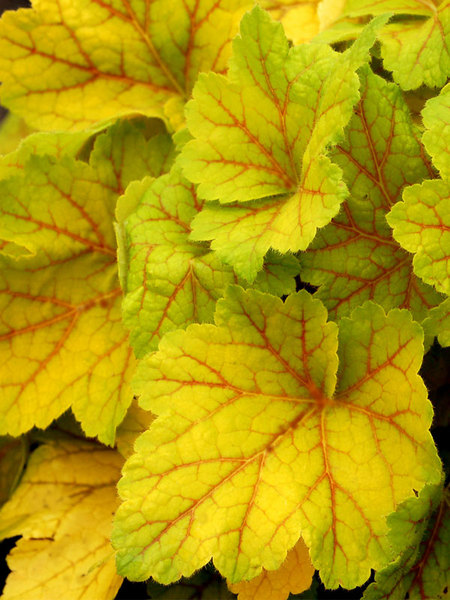
Perennials for Hummingbirds – Electra Heuchera
Electra Heuchera has short spikes of white blooms. Foliage has electric red veining across bright green yellow foliage turning chartreuse in the Summer. In the Fall, foliage turns to soft red. Blooms in the summer. Grows in zones 4 to 9 in full shade to part Sun and part shade. Reaches 8 inches tall. Attracts butterflies and hummingbirds. Use as cut flowers. An evergreen perennial, plant as edgers or in containers. Tolerant of shade conditions. Another delightful heuchera from Dan Heims and his team at Terra Nova.

Perennials for Hummingbirds – Glitter Heuchera
Glitter Heuchera has sprays of fuchsia pink blooms. Foliage is a polished silver with contrasting black veins over tidy mounds. Blooms from late Spring to early Summer. Grows in zones 4 to 9 in mostly shady to part shade and part sun to full Sun. Tops out at 10 inches. Attracts butterflies and hummingbirds. An evergreen perennial that can be grown in a container. Blooms make for great cut flowers. Tolerant of full shade conditions.
8. Clematis
Clematis are sometimes referred to as the “Queen of the Climbers”. Prized for their large and beautiful flowers. They can be trained on trellises, fences, or garden archways. Directly below is an upright (non-climbing) growing Clematis. A climbing clematis follows the non-climbing variety that hummingbirds love.

Stand By Me Bush Clematis is a non-vining herbaceous Clematis. It has blue bell-shaped blooms. Blooms from late Spring to mid Summer. Grows in zones 3 to 7 in part shade and part Sun to full Sun. Reaches 34 to 38 inches tall. Attracts hummingbirds. For support, stake Stand By Me Bush clematis or add a caging support. Plant Stand by Me in garden borders, containers, or use as cut flowers. Perfect for a small space garden. Use on a small garden balcony, deck garden or patio.

Edda Clematis is a vine perennial that has purple with red-slashed accent blooms. Blooms from late Spring to late Summer. Grows in zones 4 to 10 in half shade and half Sun to full Sun. Reaches between 3 to 4 feet tall. Beneficial for pollinators. Attracts butterflies, and hummingbirds. Long blooming clematis that can be planted in containers. Provides vertical interest to the garden.
9. Aquilegia
Aquilegia is also known as Columbine. Self-sowing Spring blooming. Does best in evenly moist, rich soil.

Clementine Red Aquilegia has large fuchsia red flowers. Foliage is lace green with larger leaved foliage. Blooms mid-Spring to early Summer. Grows in zones 3 to 9 in mostly shady to full Sun garden conditions. Reaches 18 inches tall. Beneficial for pollinators. Attracts butterflies and hummingbirds. Resistant to deer and rabbit. Makes great cut flowers. Tolerant of shade. Long blooming Clementine Red make beautiful floral bouquets.

Songbird Cardinal Aquilegia has large 3 inch red/white bicolor blossoms. Blooms from late Spring to early Summer. Grows in zones 3 to 9 in part shade and part Sun to full Sun. Reaches between 20 to 28 inches tall. Part of the songbird series which have upward facing blossoms. Attracts hummingbirds. Deer resistant. Tolerant of drought conditions.
10. Echinacea
Echinacea is also known as a coneflower. Colorful, easy to grow. Butterflies are attracted to the flowers. Birds love the seeds that the cone center develops. Seed heads are provide winter interest to the garden.

Fragrant Hope Echinacea has pastel pink petal blooms with an orange center. Blooms from early Summer to early Fall. Grows in zones 4 to 9 in part shade and part Sun to full Sun. Reaches 20 inches tall. Beneficial for pollinators, attracts butterflies and hummingbirds. Deer resistant. Use Hope Echinacea as cut flowers or plant in containers. Long blooming. Tolerant of clay soil conditions, humidity and hot dry garden site conditions.

Compact Lakota Fire Echinacea has reddish orange to pinkish red blooms. Blooms in Summer through Fall. Grows in zones 4 to 8 in part Sun and part shade to full Sun. Tops out between 12 to 16 inches tall. Fragrant Lakota Fire is long blooming Attracts butterflies and hummingbirds. North American native and deer resistant. Plant along garden borders, in mass plantings, or in containers. Perfect for small space gardens. Grow in sunny and hot locations with well-draining soils. Tolerant of light shade. Prefers full Sun. Tolerant of drought conditions once established.
11. Hemerocallis
Hemerocallis is also known as a Daylily. Hardy Hemerocallis have vibrant colored blooms. Loved by butterflies and hummingbirds. Quick to establish and have low maintenance needs. Hemerocallis resists pests and is free of hemerocallis rust disease. Can be grown under Black Walnut trees or along salted driveways. Tolerant of cold and drought conditions.

Orange Smoothie Hemerocallis has orange mango petals with a light rose band. Fragrant blooms appear in mid Summer. Grows in zones 3 to 9 in part shade and part Sun to full Sun. Reaches 20 to 24 inches tall. Attracts butterflies and hummingbirds. Rabbit resistant. Easy to grow and continuous blooming perennial. Provides erosion control. Tolerant of salt conditions. Plant in landscapes. For best flowering conditions, plant in full Sun. Part of the Rainbow Rhythm series, adaptable to a variety of soil conditions.

South Seas Hemerocallis has fragrant orange peach blooms. A blend of sunset pink with coral tones create a tropical effect on ruffled petals. A coral throat and a touch of golden highlights warm the 5 inch blossoms. Blooms early to mid Summer. Grows in zones 3 to 9 in mostly sunny to full Sun. Reaches 30 inches tall. Attracts butterflies and hummingbirds. Rabbit resistant. Long blooming. Plant in containers. Soil condition tolerant of clay and acidic soils. Tolerant of hot dry site and seaside/salt conditions. Once established, tolerant of drought conditions. A tetraploid has an abundance of blooms with vibrant colors.
12. Penstemon
Penstemon is also known as beardtongue plants. A North American native plant produces tubular flowers that attract butterflies and hummingbirds. Long blooming and does well in a drier climate. Provide good drainage soil for Penstemon. Once established, tolerant of drought conditions.

Margarita BOP Penstemon has sky blue with purple blooms. Buds are yellow which open to sky blue flowers that mature to hues of blue, violet, and purple. Foliage is deep-green, fine and linear. Snapdragon-like blooms from early to mid Summer. Grows in zones 6 to 10 in mostly Sunny to full Sun. Reaches 2 feet tall. Beneficial for pollinators. Attracts butterflies and hummingbirds. Long blooming. Use for cut flower arrangements. Tolerant of clay soil. Once established, tolerant of drought conditions.
Note: BOP refers to the location where the plant was discovered. BOP stands for “Bottom of the Porch”. Found at the Las Pilitas Nursery in Santa Margarita, California.

Midnight Masquerade Penstemon has rich, lavender purple with white interior flowers on dark stems. Foliage is deep eggplant purple color. Blooms in early to mid Summer. Grows in zones 3 to 8 in full Sun. Reaches 36 to 40 inches tall. Provides foliage interest. Once established, tolerant of drought conditions. Tolerant of salt conditions. Attracts hummingbirds. Plant in garden beds or containers. Best grown in full Sun with dry to average soil.
13. Perovskia
Perovskia is also known as Russian Sage. Aromatic shrub like plants. Long spikes of silvery-blue flowers that accent the silver-gray foliage. Shrub size and semi-woody plants that love Sun. Blooms from Summer into early Fall. Once established, tolerant of drought conditions. Does not like wet soil conditions.

Denim n’ Lace Perovskia has bright sky blue purple blooms with amethyst calyxes. Blooms mid Summer to mid Fall. Grows in zones 4 to 9 in full Sun. Reaches 28 to 32 inches tall. Fragrant foliage. Attracts hummingbirds. Deer resistant. Once established, tolerant of drought conditions. Tolerant of salt conditions. Plant in garden beds. Use as cut flowers. Grows best in full sun and dry to average, well-drained soils.
14. Veronica
Veronica is also known as Speedwell. Provides beautiful long lasting blues, rich purples, pinks, and whites in perennials. Likes evenly moist soil with good drainage.

Blue Skywalker Veronica has purple blue spires full of blooms. Blooms in the Summer and Fall. Grows in zones 4 to 9 in full Sun. Reaches 28 to 30 inches tall. Attracts butterflies and hummingbirds. Deer resistant. Plant in garden beds and borders or containers. Use as cut flowers. A compact perennial with stunning blue spikes.

Icicle Veronica has 6 inch spikes sparkling white florets. Especially stands out at night as well as the day. Pure white spikes with light green foliage. Blooms from early to late Summer. Grows in zones 4 to 8 in part shade and part Sun to full Sun. Reaches 26 inches tall. Tolerates clay and sandy soil conditions. Attracts butterflies and hummingbirds. Deer and rabbit resistant. Use as cut flowers. Tolerates hot dry site and seaside/salt conditions.
15. Asclepias
Asclepias are known as Whorled or Horsetail Milkweeds. Thrive in sandy soil in sunny garden areas. Foliage is similar to needle-like appears in whorls of 3-6 at each node. A nectar source for Monarch butterflies. And host plant for Monarch butterflies to lay eggs. Low maintenance but an important perennial. Plant in large groups to attract more Monarch butterflies.
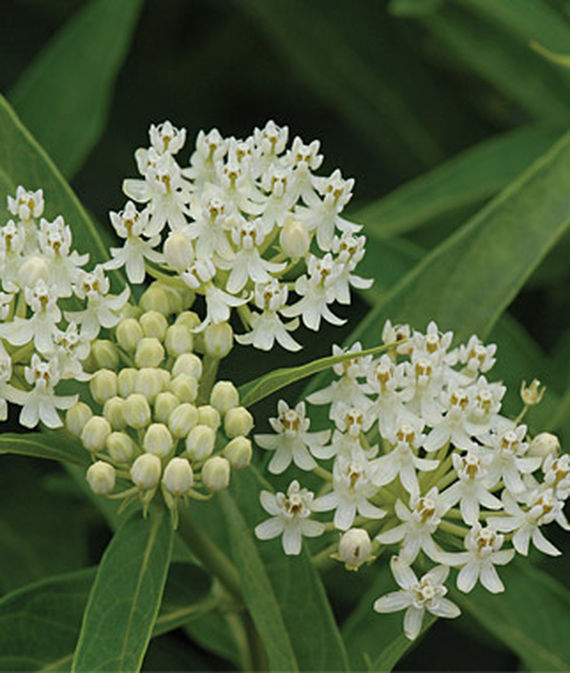
Ice Ballet Asclepias has clustered clouds of small, fragrant tiny white 1/4 inch blooms. Clustered clouds are above 3 to 3 1/2 tall stalks. Blooms Spring and Summer. Flowers become attractive seed pods. Grows in zones 3 to 9 in part shade and part sun to full Sun. Reaches 36 to 48 inches tall. Attracts butterflies and hummingbirds. Deer resistant. Tolerant of drought conditions. Plant in garden beds or borders. Flowering clusters later become seed pods.
16. Dicentra
Dicentra is also known as bleeding heart. Flowers on slender stems with fern like foliage appear in Spring.

Valentine Dicentra has deep red and white heart-shaped blooms. Puffy heart chains dangle along frosted plum colored stems in late Spring. Blooms late Spring to early Summer. Grows in zones 3 to 9 in full shade to part shade and part Sun. Reaches 30 inches tall. Attracts hummingbirds. Deer resistant. Tolerant of acidic soil conditions. Tolerant of shade. Use as cut flowers.
Create a continuous nectar banquet in your garden for hummingbirds. Plant a variety of perennials to attract hummingbirds. Grow plants that provide nectar throughout the seasons. Plants with a wide range of blooming periods.
Perennial plants that bloom over the Spring, Summer, and Fall seasons are best. Talk to your neighbors about creating a neighborhood banquet for hummingbirds. The reward? The presence of these lovely birds in your neighborhood! Provide a diverse range of perennials for hummingbirds to feast on.
Interested in gardening for pollinators? If you found this helpful . . .
You May Also Enjoy some of our other gardening related posts.
12 Perennials That Butterflies Find Irresistible
15 Bee Friendly Perennials to Make Your Garden Buzz
How to Create a Wildlife Sanctuary With Native Plants
23 Fall Blooming Plants for Pollinators
We are always thrilled when we see hummingbirds in our garden. And we’re sure, you too will be just as thrilled to see them in your garden. If you try any of these 16 perennials for hummingbirds let us know how you make out. And if you have any questions, feel free to reach out to us. We always are ready to help you out. Thank you for dropping by.
Mary























very informative! Great site
Thanks for the feedback Linda – so happy you find the site helpful. Happy gardening! Mary@FindingSeaTurtles
Thanks for all the plant suggestions to attract the hummingbirds. I uprooted my trumpet vines which has left me feeling bad.Hopefully some of these replacements will be as good
Hi Yvonne,
So sorry to hear about the trumpet vines. We are glad that you’ve found something to replace the lost of the trumpet vine.
We’re sure that the visiting Hummingbirds will appreciate what you plant for them.
Happy Gardening! Mary
I have many of these flowers in my garden, plus a hummingbird and butterfly feeder and a water plate and I am still not getting either of them. Is there something that could be driving them away? Thank you!
Love the suggestions for humming birds. Any recommendations for locating the nursery that sells these Agastache and the Heuchera. I a new to the Atlanta area and I do not see any at the local nurseries
Hi Renita,
If you click on the image or picture of the flower you are interested in, it will redirect you to the nursery that sells that particular plant. It is possible that the plant is sold out for the season or year.
I’ve listed three different nurseries that will ship Agastache and Heuchere this Fall (2020). The third link for the Heuchera has a few Heuchera (Coral Bells) for Fall 2020 but most Heuchera they have available will ship next Spring (Spring 2021)
Agastache or Hyssop Plants (Hummingbird Mint)
High Country Nursery – website
Wits End Gardens – website
Bluestone Nursery – website
Heuchera or Coral Bells
High Country Nursery – website
Wits End Gardens – website
Bluestone Nursery – website (only a few Heuchera are available for Fall 2020 shipping)
If you are new to the Atlanta area, I have heard that the soil in Georgia is very acidic. You may want to test your soil before you plant anything new. If your garden soil is highly acidic, you may want to amend the garden soil before planting anything that doesn’t tolerate acidic soil.
Thanks for reading our blog. Hope this helps you. And happy gardening! – Mary @ FindingSeaTurtles.com
Hi there, I was pleasantly surprised 2 weeks ago when a hummingbird visited It enjoyed the butterfly bush that was in healthy bloom. Thanks for all the other plant suggestions. I am certainly going to try planting as many as I can.